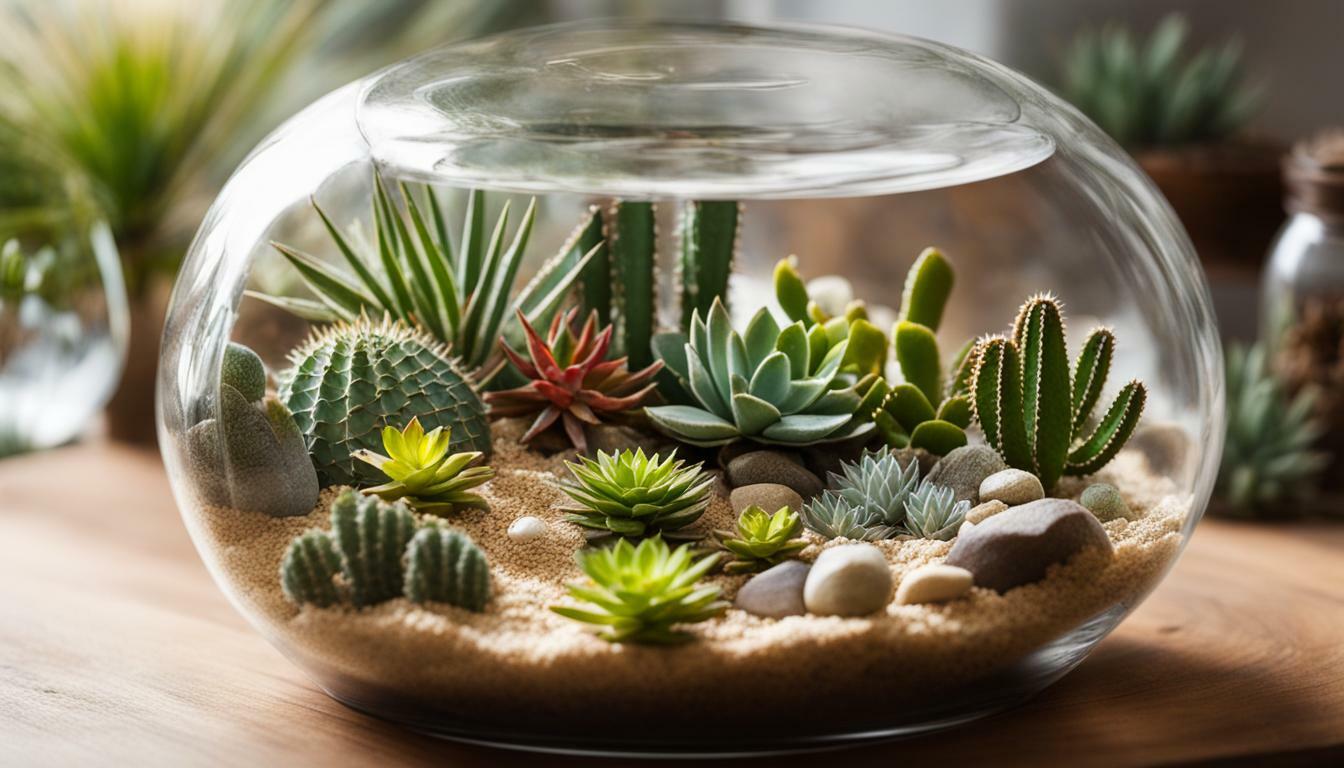Welcome to our ultimate guide on terrarium plants desert plants, where we explore the world of indoor gardening and the wonders of desert plants in terrariums. Terrariums are miniature gardens in glass containers that allow you to bring a touch of nature into your home. They are not only aesthetically pleasing but also require minimal maintenance, making them perfect for busy individuals who want to enjoy the beauty of plants without the hassle.
- Terrariums are miniature gardens in glass containers that allow you to bring nature indoors.
- Desert plants, such as succulents and cacti, are ideal for terrariums due to their low maintenance and drought-tolerant nature.
- When selecting terrarium plants, consider the size of your terrarium and the natural habitat of the plants.
- Caring for terrarium plants involves proper watering, providing the right light conditions, and considering their humidity preferences.
- Easy terrarium plants for beginners include artillery ferns, aluminum plants, polka dot plants, golden pothos, ripple plants, prayer plants, and button ferns.
Now, let’s dive deeper into the fascinating world of terrarium plants desert plants and discover the perfect additions to create your own indoor oasis!
What are Terrarium Plants and Why Choose Desert Plants?
Terrarium plants are specially chosen plants that thrive in the unique environment of a terrarium, and desert plants make an excellent choice for these miniature indoor gardens. With their low maintenance requirements and ability to thrive in arid conditions, desert plants are well-suited for terrarium gardening. They not only add a touch of natural beauty to your home but also bring a sense of serenity and tranquility.
One of the key benefits of choosing desert plants for terrariums is their ability to tolerate low levels of water. These plants have adapted to survive in arid climates and are drought-tolerant, which means they require less watering compared to other plant varieties. This makes them ideal for those who have busy schedules or lack a green thumb but still want to enjoy the beauty of indoor gardening.
Another advantage of desert plants is their low maintenance nature. They typically have minimal care requirements, making them perfect for beginners or individuals who want hassle-free plants. Desert plants thrive in bright, indirect light, so placing your terrarium near a window with filtered sunlight is ideal. Additionally, their ability to retain water allows them to survive in dry conditions, reducing the need for frequent watering.
What Makes Desert Plants Suitable for Terrariums?
Desert plants are well-suited for terrariums due to their ability to adapt to the unique conditions that these enclosed environments offer. Terrariums create a microclimate with higher humidity, which mimics the arid habitats that desert plants are accustomed to. Their ability to retain water and tolerate dry conditions makes them the perfect choice for terrarium gardening.
When selecting desert plants for your terrarium, consider their growth habit and size. Smaller, slow-growing varieties work best in enclosed spaces. Some popular options include cacti, succulents, and other low-maintenance plants such as aloe vera, agave, and echeveria. These plants not only thrive in arid climates but also add visual interest with their unique shapes and textures.
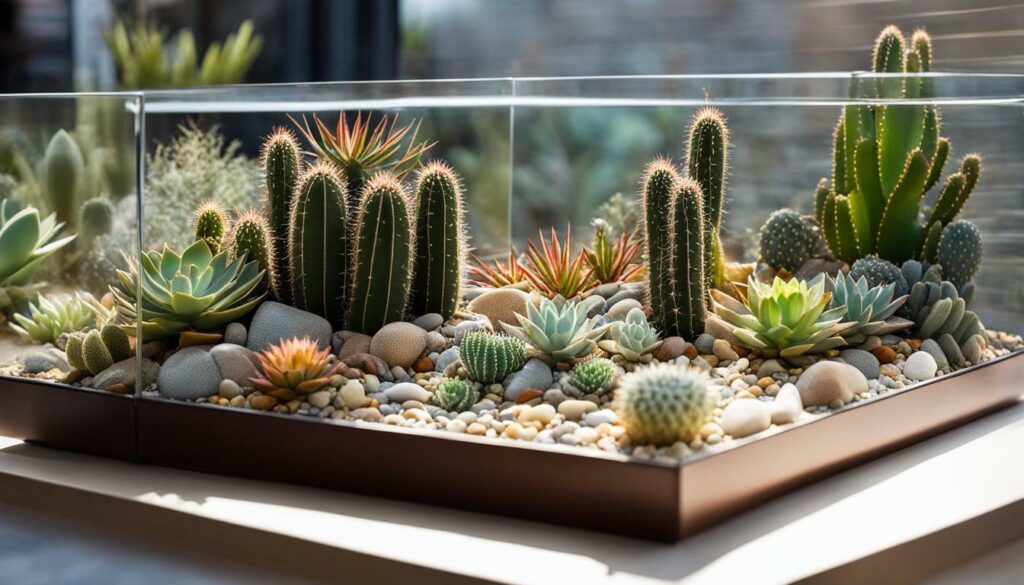
To summarize, terrarium plants are specially chosen plants that thrive in the unique environment of a terrarium. Desert plants, with their low maintenance requirements and ability to tolerate dry conditions, make an excellent choice for terrarium gardening. They add natural beauty to your home while requiring minimal care, making them perfect for both beginners and experienced indoor gardeners.
| Terrarium Plant Types | Benefits |
|---|---|
| Cacti and Succulents | Low maintenance, unique shapes and textures |
| Aloe Vera | Aids in air purification, soothing gel for burns and skin conditions |
| Agave | Drought-tolerant, adds architectural interest |
| Echeveria | Rosette-shaped leaves, vibrant colors |
Choosing the Right Terrarium Plants for Different Sizes
The size of your terrarium will determine the type of terrarium plants you should choose, with various options available for small, medium, and large terrariums. When selecting plants for your terrarium, it’s important to consider their natural habitat, growth rate, and the space available.
For small terrariums, mosses, air plants, and baby tears are excellent choices. These plants thrive in the limited space and can add a touch of greenery to your miniature garden. Mosses, in particular, create a lush and natural appearance, while air plants require minimal care and add an interesting element to the terrarium.
If you have a medium-sized terrarium, consider plants like nerve plants, spiderwort, and polka dot plants. These plants have moderate growth rates and can fill the space without overwhelming it. Their vibrant colors and unique foliage patterns will create a visually appealing display in your terrarium.
For larger terrariums, you have more options to choose from. Maidenhair ferns, peace lilies, and snake plants are ideal choices for their size and ability to thrive in a larger environment. These plants will add height and texture to your terrarium, creating a captivating and impressive display.
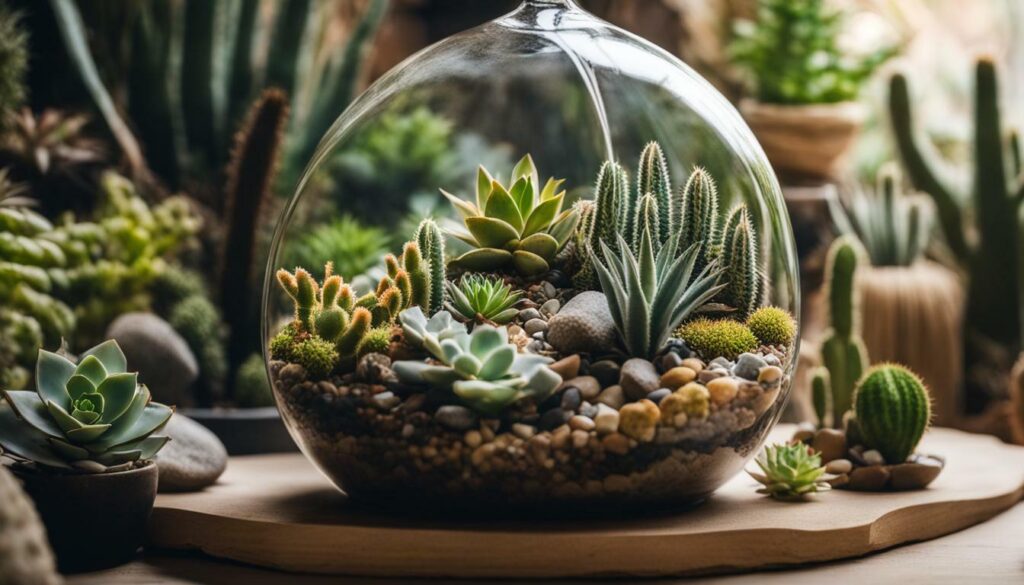
Caring for Terrarium Plants: Essential Tips
Caring for terrarium plants involves proper watering, providing the ideal light conditions, and considering their humidity preferences, whether you have a closed or open terrarium. Understanding these key factors will help you create a thriving and visually appealing terrarium garden.
Watering
Watering terrarium plants can be a delicate task. It’s important to strike the right balance, as overwatering can lead to root rot, while underwatering can result in plant wilting. A good rule of thumb is to water your terrarium plants when the top layer of the soil feels dry to the touch. Use a spray bottle to mist the soil gently, ensuring that the water reaches the roots without saturating the entire terrarium.
Light Conditions
Lighting is another important factor to consider when caring for terrarium plants. Most desert plants, such as cacti and succulents, thrive in bright, indirect light. Place your terrarium in a location where it receives plenty of natural light, such as near a sunny window. However, be cautious of direct sunlight, as it can scorch the plants and cause damage. If you’re using artificial light sources, choose bulbs that emit a spectrum similar to natural sunlight.
Humidity Preferences
When selecting terrarium plants, it’s crucial to consider their humidity preferences. Some plants, like ferns and mosses, thrive in high humidity environments. These plants are best suited for closed terrariums, which trap moisture and create a humid microclimate. On the other hand, plants like cacti and succulents prefer lower humidity levels and are better suited for open terrariums that allow for fresh air circulation. Be sure to research the specific humidity requirements of each plant you choose to ensure their long-term health.
| Terrarium Type | Humidity Level | Plant Recommendations |
|---|---|---|
| Closed Terrariums | High humidity | Peace lilies, ferns, mosses |
| Open Terrariums | Lower humidity | Cacti, succulents, air plants |
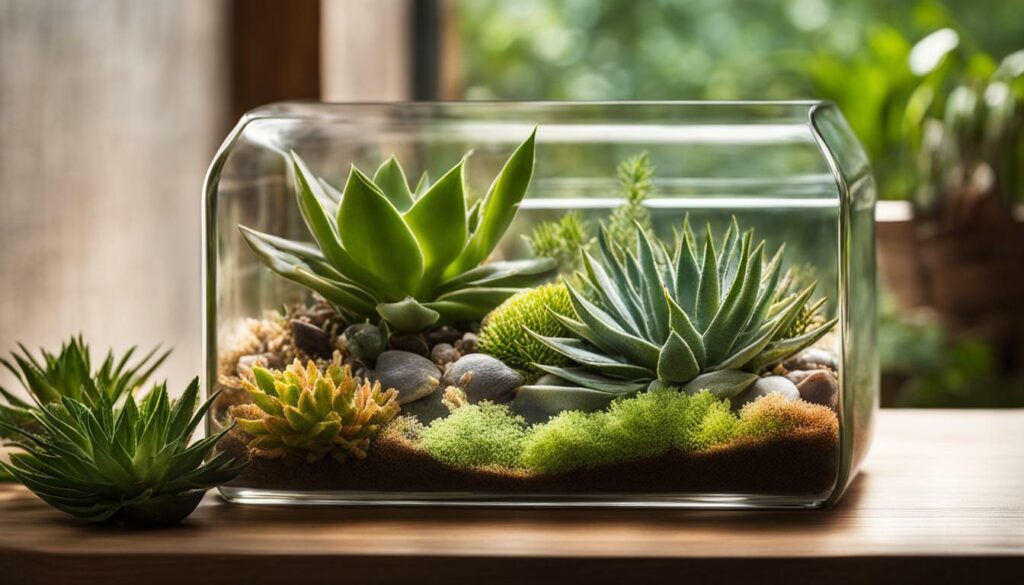
“Caring for terrarium plants involves proper watering, providing the ideal light conditions, and considering their humidity preferences, whether you have a closed or open terrarium.” – Terrarium Gardening Expert
By understanding and implementing these essential care tips, you can create a flourishing terrarium garden that will bring beauty and a touch of nature to your home. Remember to monitor and adjust the watering, lighting, and humidity levels as needed, and enjoy the tranquility and greenery that terrarium plants offer.
Easy Terrarium Plants for Beginners
If you’re new to terrarium gardening, there are several easy-to-care-for plants that are perfect for beginners. These plants require minimal maintenance and can thrive in the unique environment of a terrarium. Here are some options to consider:
| Plant | Description |
|---|---|
| Artillery Ferns | Artillery ferns are compact plants with delicate foliage that add a touch of elegance to any terrarium. They prefer bright, indirect light and require regular misting to maintain their humidity levels. |
| Aluminum Plants | Aluminum plants are known for their attractive silver markings on their leaves. They can tolerate low light conditions and are relatively easy to care for. Just make sure to keep the soil moist but not waterlogged. |
| Polka Dot Plants | Polka dot plants are named for their vibrant splashes of color on their foliage. They thrive in bright, indirect light and prefer slightly higher humidity levels. Regular pruning will help to maintain their compact shape. |
| Golden Pothos | Golden pothos is a popular houseplant that is well-suited for terrariums. It has trailing vines and attractive heart-shaped leaves. This plant is low-maintenance and can tolerate a variety of light conditions. |
| Ripple Plants | Ripple plants have uniquely textured leaves that add visual interest to a terrarium. They prefer bright, indirect light and well-draining soil. Avoid overwatering to prevent root rot. |
| Prayer Plants | Prayer plants are known for their beautiful foliage that folds up at night, resembling hands in prayer. They prefer bright, indirect light and humidity levels around 50-60%. Regular misting will help to maintain their humidity requirements. |
| Button Ferns | Button ferns are compact ferns with small, round leaves that add a touch of lushness to a terrarium. They prefer bright, indirect light and consistent moisture. Avoid letting the soil dry out completely. |
These easy terrarium plants for beginners will not only add greenery to your home but also provide a sense of tranquility and relaxation. Experiment with different combinations to create a terrarium that suits your style and enjoy the beauty of nature in your own indoor oasis.
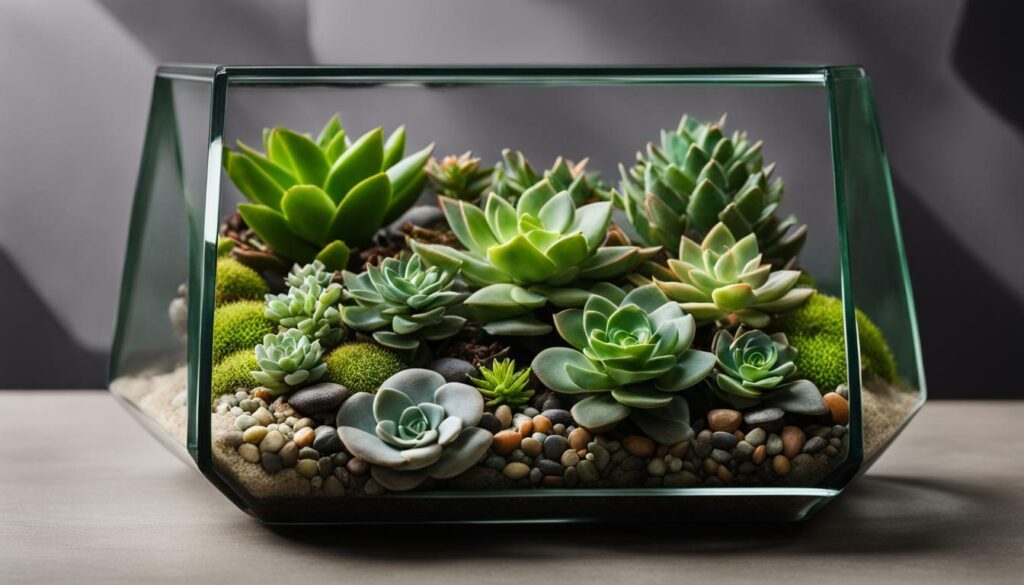
If you’re new to terrarium gardening, there are several easy-to-care-for plants that are perfect for beginners, including artillery ferns, aluminum plants, polka dot plants, golden pothos, ripple plants, prayer plants, and button ferns. These plants require minimal maintenance and can thrive in the unique environment of a terrarium. Here are some options to consider:
| Plant | Description |
|---|---|
| Artillery Ferns | Artillery ferns are compact plants with delicate foliage that add a touch of elegance to any terrarium. They prefer bright, indirect light and require regular misting to maintain their humidity levels. |
| Aluminum Plants | Aluminum plants are known for their attractive silver markings on their leaves. They can tolerate low light conditions and are relatively easy to care for. Just make sure to keep the soil moist but not waterlogged. |
| Polka Dot Plants | Polka dot plants are named for their vibrant splashes of color on their foliage. They thrive in bright, indirect light and prefer slightly higher humidity levels. Regular pruning will help to maintain their compact shape. |
| Golden Pothos | Golden pothos is a popular houseplant that is well-suited for terrariums. It has trailing vines and attractive heart-shaped leaves. This plant is low-maintenance and can tolerate a variety of light conditions. |
| Ripple Plants | Ripple plants have uniquely textured leaves that add visual interest to a terrarium. They prefer bright, indirect light and well-draining soil. Avoid overwatering to prevent root rot. |
| Prayer Plants | Prayer plants are known for their beautiful foliage that folds up at night, resembling hands in prayer. They prefer bright, indirect light and humidity levels around 50-60%. Regular misting will help to maintain their humidity requirements. |
| Button Ferns | Button ferns are compact ferns with small, round leaves that add a touch of lushness to a terrarium. They prefer bright, indirect light and consistent moisture. Avoid letting the soil dry out completely. |
These easy terrarium plants for beginners will not only add greenery to your home but also provide a sense of tranquility and relaxation. Experiment with different combinations to create a terrarium that suits your style and enjoy the beauty of nature in your own indoor oasis.

If you’re looking to add more variety to your terrarium collection, consider these additional plant options, including creeping fig, crotons, and hens and chicks succulents. Creeping fig (Ficus pumila) is a popular choice for its fast-growing nature and ability to create a lush, cascading effect in your terrarium. It thrives in bright, indirect light and benefits from regular pruning to maintain a neat appearance.
Crotons (Codiaeum variegatum) are known for their vibrant foliage, with leaves that come in a range of colors, including red, orange, yellow, and green. They add a splash of color and visual interest to any terrarium. Crotons prefer bright, indirect light and thrive in warm, humid environments.
Hens and chicks succulents (Sempervivum spp.) are low-growing, rosette-shaped succulents that are hardy and easy to care for. They store water in their leaves, making them drought-tolerant and ideal for terrariums. Hens and chicks prefer bright, indirect light and well-draining soil.
| Plant | Light Conditions | Watering |
|---|---|---|
| Creeping Fig | Bright, indirect light | Allow the soil to dry between waterings |
| Crotons | Bright, indirect light | Water when the top inch of soil feels dry |
| Hens and Chicks Succulents | Bright, indirect light | Water sparingly, allowing the soil to dry completely between waterings |
These additional terrarium plant options provide a range of colors, textures, and growth habits to suit your preferences. Whether you’re looking for a trailing plant, vibrant foliage, or a drought-tolerant succulent, these plants will add beauty and diversity to your terrarium. Remember to consider their specific light and watering requirements to ensure their optimal growth and health.
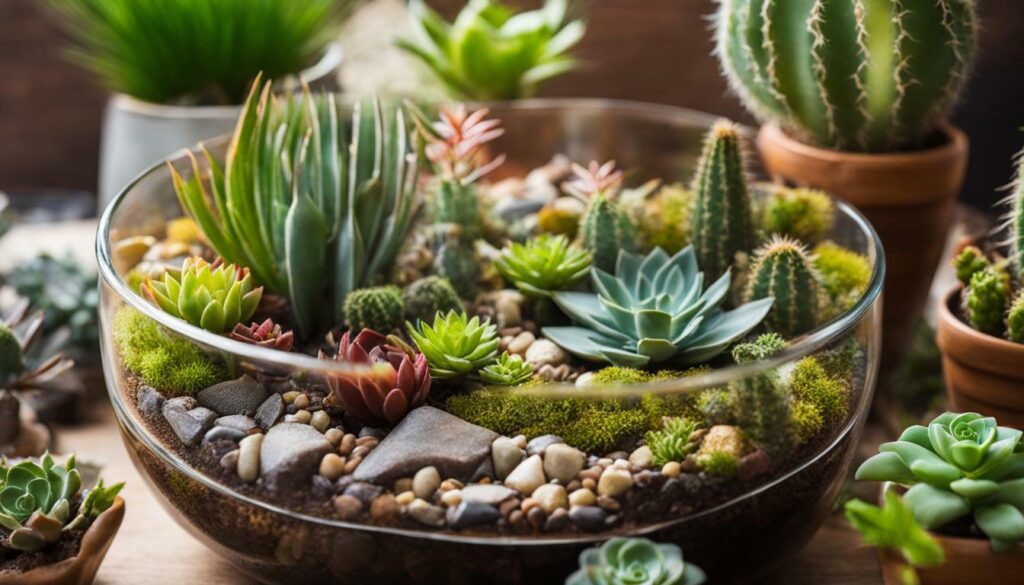
African violets are a beautiful choice for closed terrariums, but it’s essential to take proper care to avoid water buildup. These delicate plants, with their vibrant blooms and fuzzy leaves, thrive in the humid environment created by closed terrariums. However, excessive moisture can lead to root rot and other issues, so it’s crucial to follow a few key guidelines to keep your African violets healthy and happy.
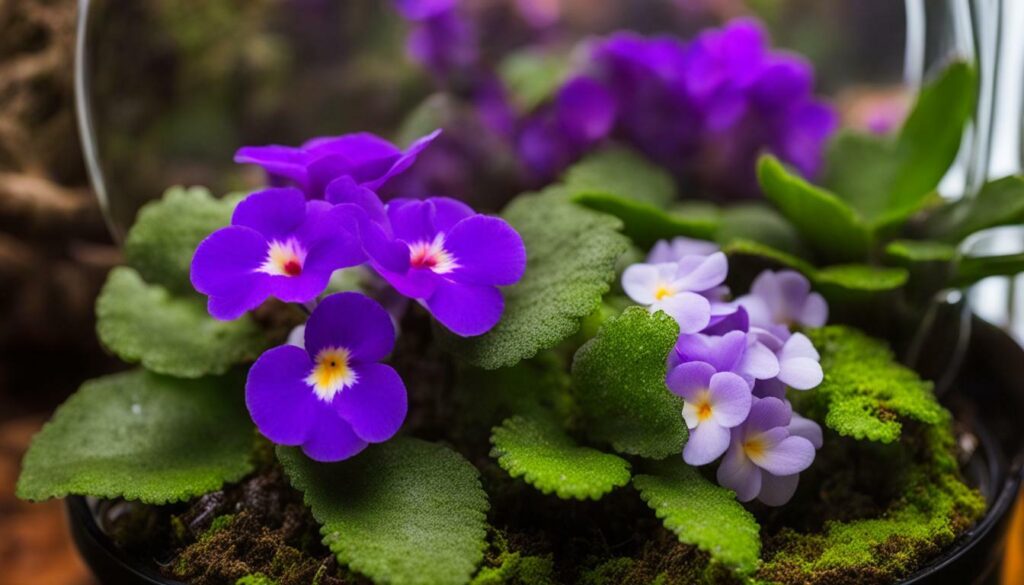
To prevent water buildup in your closed terrarium, it’s important to choose the right container and provide adequate drainage. Select a container with a tight-fitting lid to create a sealed environment, but ensure it has small ventilation holes to prevent excess moisture buildup. Use a layer of pebbles or activated charcoal at the bottom of the terrarium to improve water drainage.
When watering your African violets, make sure to do so sparingly. Overwatering is the most common cause of water buildup in closed terrariums. Allow the top inch of soil to dry out before watering and avoid getting water on the leaves, as this can lead to rot. Check the moisture level by gently pressing your finger into the soil. If it feels dry, it’s time to water, but if it feels moist, hold off until it dries out a bit.
Caring for African Violets
In addition to preventing water buildup, African violets require specific care to thrive in closed terrariums. They prefer bright but indirect light, so placing them near a window with filtered light is ideal. Avoid exposing them to direct sunlight, as this can cause leaf damage.
It’s also important to provide a consistent temperature for African violets. They thrive in temperatures between 65 and 75 degrees Fahrenheit (18 to 24 degrees Celsius). Avoid placing them near drafts or in areas with extreme temperature fluctuations.
By following these guidelines, you can enjoy the beauty of African violets in your closed terrarium. Their lush foliage and colorful flowers will add a touch of elegance to your indoor garden.
Enjoying Terrarium Plants in Your Home
Terrarium plants not only add beauty to your home but also contribute to air purification and create a welcoming and refreshing atmosphere. These miniature gardens in glass containers are a perfect way to bring nature indoors and create a unique focal point in any room. The lush greenery of terrarium plants enhances the overall aesthetic of your home decor, creating a serene and calming environment.
But the benefits of terrarium plants go beyond their visual appeal. They also play a crucial role in improving indoor air quality. As plants photosynthesize, they absorb carbon dioxide and release oxygen, helping to purify the air and create a healthier living space. In addition, terrarium plants can help to regulate humidity levels and reduce the presence of airborne pollutants, providing a breath of fresh air in your home.
To fully enjoy the benefits of terrarium plants, it’s important to choose the right plants for your terrarium and provide them with the proper care. Consider the size of your terrarium when selecting plants, as different plants have different growth rates and space requirements. Small terrariums are perfect for mosses, air plants, and baby tears, while medium-sized terrariums can accommodate nerve plants, spiderwort, and polka dot plants. For larger terrariums, maidenhair ferns, peace lilies, and snake plants are excellent choices.
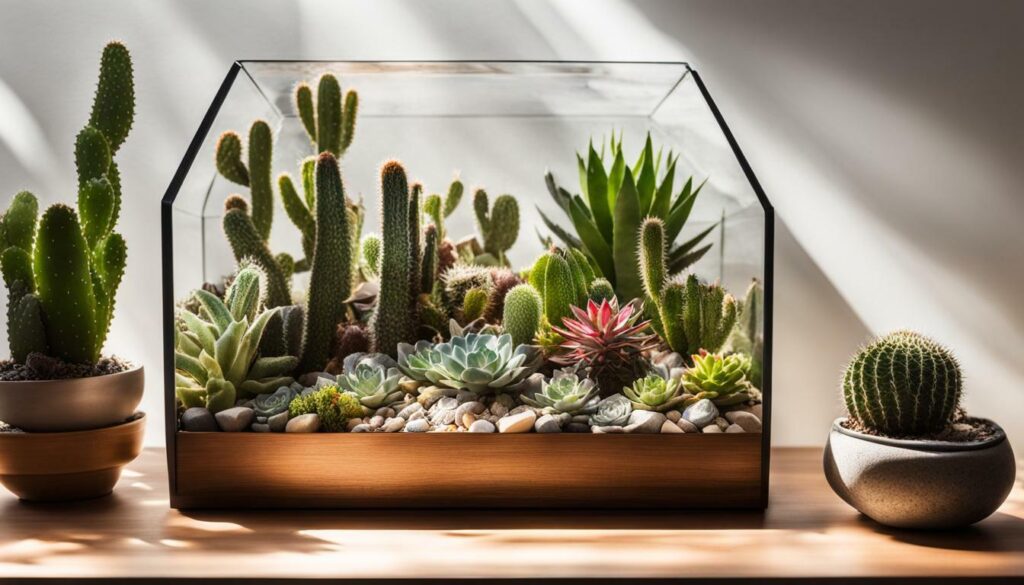
Creating a Welcoming Atmosphere
In addition to their air-purifying qualities, terrarium plants create a welcoming atmosphere in your home. The lush green foliage and unique glass containers add a touch of elegance and tranquility to any room. Whether you place your terrarium on a windowsill, on a coffee table, or as a centerpiece on your dining table, it will surely become a conversation starter and a focal point of your home decor.
Furthermore, terrariums offer endless opportunities for creativity and personalization. You can experiment with different containers, soil compositions, and plant arrangements to create a unique and visually appealing terrarium that suits your style and preferences. From minimalist designs to whimsical fairy gardens, the possibilities are endless.
| Terrarium Plants | Benefits |
|---|---|
| Artillery Ferns | Add delicate texture and color to your terrarium. |
| Aluminum Plants | Display stunning silver markings on their leaves. |
| Polka Dot Plants | Bring a splash of vibrant color to your terrarium. |
| Golden Pothos | Purify the air and thrive in low light conditions. |
| Ripple Plants | Provide a unique textured look with their wavy leaves. |
| Prayer Plants | Display stunning patterned leaves that fold up at night. |
| Button Ferns | Bring a touch of elegance and grace to your terrarium. |
By incorporating terrarium plants into your home decor, you not only create a visually pleasing environment but also improve the air quality and enjoy the therapeutic benefits of nature. So go ahead, unleash your creativity, and bring the beauty of terrarium plants into your home.
Creating and Maintaining a Terrarium
Creating and maintaining a terrarium is an enjoyable process that requires careful planning, appropriate materials, and regular maintenance. Before starting, decide on the type of terrarium you want to create – a closed or open terrarium. Closed terrariums create a humid environment that is perfect for humidity-loving plants, while open terrariums allow for fresh air circulation and are suitable for plants that can tolerate above-average humidity.
Once you have determined the type of terrarium, select a suitable container. Glass containers are popular choices as they provide a clear view of the plants and create an aesthetically pleasing display. Ensure that the container is clean and free from any residues or chemicals to ensure the health of your plants.
The next step is to choose the right soil and drainage materials. For a terrarium, it is essential to have well-draining soil to prevent waterlogging and root rot. A good mix of potting soil, sand, and pebbles is recommended. The sand and pebbles promote drainage, while the potting soil provides nutrients for the plants. Layer the materials accordingly – starting with a layer of rocks or pebbles at the bottom for drainage, followed by a layer of activated charcoal to prevent odors and fungus growth.
Now comes the fun part – designing your terrarium. Start by placing the larger plants first and then fill in the gaps with smaller ones. Consider the growth rate and ultimate size of the plants to avoid overcrowding. Add decorative elements, such as rocks, driftwood, or mini figurines, to enhance the visual appeal. Once you are satisfied with the layout, give your terrarium a gentle misting to settle the soil.
| Materials needed for creating a terrarium: | |
|---|---|
| Glass container | Potting soil |
| Activated charcoal | Rocks or pebbles |
| Sand | Moss or decorative elements |
Once your terrarium is set up, it’s important to maintain it properly. Terrariums require indirect sunlight, so place them in a location with bright, filtered light. Avoid placing them in direct sunlight as it can cause excessive heat and damage to the plants. Regularly monitor the moisture level of the soil and water accordingly. Overwatering can lead to root rot, while under-watering can cause the plants to wither. Mist the terrarium with water when necessary to maintain the desired humidity level.
Additionally, keep an eye out for any signs of pests or disease. Common pests that may affect terrarium plants include fungus gnats and spider mites. If you notice any pest infestation, take immediate action to prevent further damage. Regularly prune and trim the plants to maintain their shape and prevent overgrowth.
By following these steps and providing proper care, your terrarium will thrive and bring beauty to your home for years to come. Enjoy the process of creating and maintaining your own little green oasis!
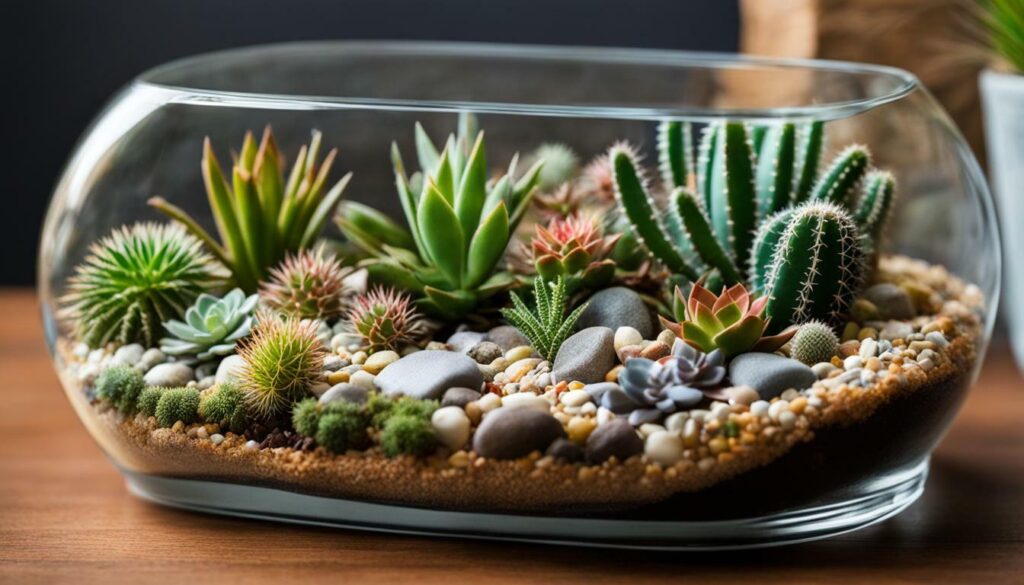
Terrarium plants, particularly desert plants, offer a captivating and low maintenance way to bring the beauty of nature into your home, creating a visually stunning and refreshing indoor oasis. A terrarium is like a miniature garden in a glass container, allowing you to enjoy the wonders of nature up close and personal. The best part is, these plants require very little attention, making them perfect for busy individuals or those without a green thumb.
When choosing plants for your terrarium, it’s important to consider their natural habitat and their growth characteristics. Mosses, air plants, and baby tears are excellent options for small terrariums, as they stay compact and add a touch of greenery. For medium-sized terrariums, nerve plants, spiderwort, and polka dot plants are suitable choices, thanks to their vibrant colors and moderate growth. If you have a larger terrarium, go for maidenhair ferns, peace lilies, or snake plants, as they can fill up the space and create a lush indoor jungle.
Caring for terrarium plants is fairly straightforward. Proper watering is essential, as overwatering can lead to root rot, while underwatering can cause the plants to wither. Additionally, it’s important to provide the right amount of light for your plants. Desert plants, for instance, thrive in bright, indirect sunlight, while other varieties may prefer shadier conditions. Lastly, consider the humidity preferences of your terrarium plants. Closed terrariums offer a humid environment, making them perfect for moisture-loving plants, while open terrariums allow for fresh air circulation and are suitable for plants that can tolerate higher humidity levels.
Creating a terrarium is a creative and enjoyable process. Select a container that suits your style and complements your home decor. Fill it with the right soil and drainage materials to ensure the plants thrive. Arrange your plants in a visually pleasing manner, taking into account their sizes, textures, and colors. Once your terrarium is set up, maintaining it is as simple as monitoring the watering, providing the right amount of light, and occasionally pruning and cleaning the plants. It’s a rewarding experience that allows you to enjoy the beauty of nature right in your own home.
In summary, terrarium plants, especially desert plants, offer a unique and low maintenance way to bring the beauty of nature indoors. From small succulents to vibrant foliage, there is a wide variety of terrarium plants to choose from, allowing you to create a captivating and visually stunning indoor oasis. So, why not embark on the journey of terrarium gardening and transform your home into a lush, green paradise?
What Are the Best Desert Plants for Terrariums and How to Care for Them?
When selecting the best desert plants to nurture and grow in terrariums, cacti are an excellent choice. Their low-maintenance nature makes them suitable for beginner gardeners. To care for them, provide plenty of sunlight, well-draining soil, and minimal watering. With the right conditions, these plants will thrive in your terrarium.
FAQ
What is a terrarium?
A terrarium is a miniature garden in a glass container that allows you to bring nature indoors.
What are terrarium plants?
Terrarium plants are specially chosen plants that thrive in the unique environment of a terrarium.
What are the best plants for small terrariums?
Mosses, air plants, and baby tears are great options for small terrariums due to their size and growth rate.
What plants are suitable for medium-sized terrariums?
Nerve plants, spiderwort, and polka dot plants are suitable for medium-sized terrariums.
What plants are ideal for larger terrariums?
Maidenhair ferns, peace lilies, and snake plants are ideal for larger terrariums.
How do I care for terrarium plants?
Proper watering, providing ideal light conditions, and considering humidity preferences are important aspects of caring for terrarium plants.
What is the difference between closed and open terrariums?
Closed terrariums create a humid environment, perfect for humidity-loving plants. Open terrariums allow for fresh air circulation and are suitable for plants that can tolerate above-average humidity.
What are some easy terrarium plant options for beginners?
Artillery ferns, aluminum plants, polka dot plants, golden pothos, ripple plants, prayer plants, and button ferns are easy terrarium plant options for beginners.
What are some additional terrarium plant options?
Creeping fig, crotons, hens and chicks succulents, moss, and air plants are additional terrarium plant options.
Can I use African violets in closed terrariums?
Yes, African violets are great for closed terrariums, but ensure they do not touch the sides of the container to avoid water buildup.
How do terrarium plants enhance home decor?
Terrarium plants add natural beauty to your home decor and can also help purify the air.
How do I create and maintain a terrarium?
Creating and maintaining a terrarium involves selecting the right container, choosing appropriate soil and drainage materials, and designing a visually pleasing arrangement.

